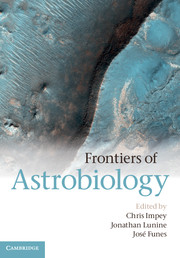Book contents
- Frontmatter
- Contents
- List of contributors
- Part I Introduction
- Part II Origin of Planets and Life
- Part III History of Life on Earth
- Part IV Habitability of the Solar System
- Part V Exoplanets and Life in the Galaxy
- 11 Searches for Habitable Exoplanets
- 12 Review of Known Exoplanets
- 13 Characterizing Exoplanet Atmospheres
- 14 If You Want to Talk to ET, You Must First Find ET
- Index
- Plate Section
- References
14 - If You Want to Talk to ET, You Must First Find ET
from Part V - Exoplanets and Life in the Galaxy
Published online by Cambridge University Press: 05 December 2012
- Frontmatter
- Contents
- List of contributors
- Part I Introduction
- Part II Origin of Planets and Life
- Part III History of Life on Earth
- Part IV Habitability of the Solar System
- Part V Exoplanets and Life in the Galaxy
- 11 Searches for Habitable Exoplanets
- 12 Review of Known Exoplanets
- 13 Characterizing Exoplanet Atmospheres
- 14 If You Want to Talk to ET, You Must First Find ET
- Index
- Plate Section
- References
Summary
Introduction
In 2010, the modern scientific search for extraterrestrial intelligence was 50 years old. Its birth was marked by Frank Drake's Project Ozma using the 85-foot diameter Tatel radio telescope at the National Radio Astronomy Observatory in Green Bank, West Virginia (Drake 1961). Project Ozma observed two nearby, Sun-like stars (Tau Ceti, 12 light-years away, and Epsilon Eridani, 10.5 light-years away) for a few hundred hours and concentrated on the precise frequency at which neutral hydrogen atoms emit radiation. Since hydrogen is the most abundant element in the galaxy, Drake assumed it would be an obvious choice for any distant engineer to use for deliberate transmission (plus he could assure the observatory's management that the equipment he built, and the money he spent, could be repurposed for traditional scientific research). After 50 years of searches at optical and radio wavelengths, the results are the same as those from Project Ozma; no signals of unambiguous extraterrestrial origin have been found, though many signals from our own technologies have confused us.
Should we give up? Conclude that we are alone? Not yet. Though 50 years seems like a long time, it's the blink of an eye to a universe that is 13.7 billion years old, or to our Milky Way Galaxy that is 10 billion years old, or even to our star the Sun that is 4.5 billion years old. The cosmos is not only old, it is vast – we've hardly begun our search. Although not everyone agrees on just how large the task of searching for ET actually is, a pretty good numerical analogy comes from trying to answer a parallel question “Are there any fish in the oceans?” by scooping an 8-ounce glass of water from some ocean and examining it to see if any fish were collected. You might have caught a fish; that experiment could have worked. But if it didn't, you're not likely to be tempted to conclude that there are no fish in the oceans. Exactly the same thing holds for SETI. More searching is required; as noted in the last sentence of the first paper on SETI published in the journal Nature in 1959, authored by Guiseppe Cocconi and Philip Morrison: “The probability of success is difficult to estimate, but if we never search, the chance of success is zero.”
- Type
- Chapter
- Information
- Frontiers of Astrobiology , pp. 286 - 305Publisher: Cambridge University PressPrint publication year: 2012
References
- 1
- Cited by



